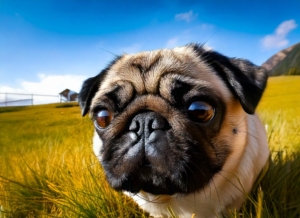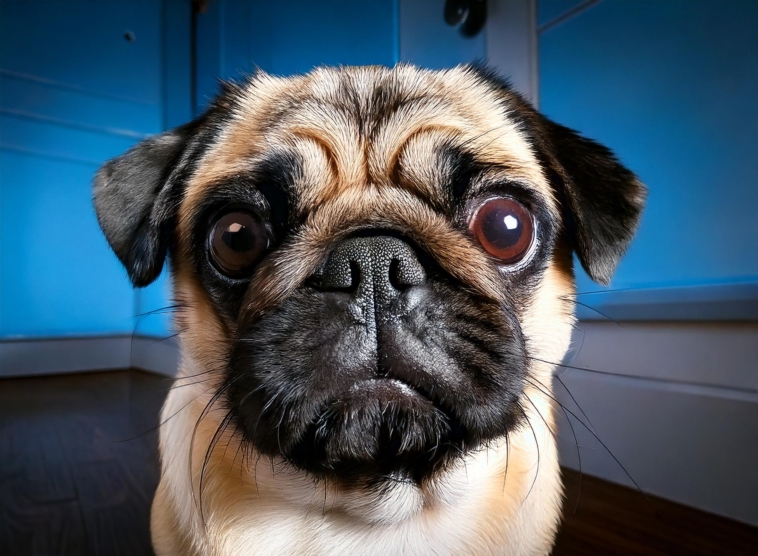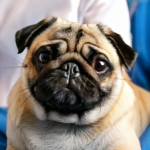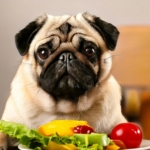Pug Eyes: Cute, Clumsy & Constantly in Trouble
Ah, the pug. A wiggly little ball of snorts, snores, and side-eyes—with eyeballs so large they appear to be attempting to burst free from their face. As irresistibly adorable as those bulging peepers are, they also have a laundry list of issues. Essentially, having a pug is subscribing to a lifetime membership in “Eye Drama Weekly.”
Common Pug Eye Ailments: The Usual Suspects
Let’s look at the pug eye problem top hits:
- Corneal Ulcers: A fancy name for “ouch, my eye!” This happens when they scratch their cornea—typically from bumping into things or rubbing their face against everything.
- Dry Eye: Your pug isn’t emotionally distant—they’re just not producing enough tears. Result: dry, irritated eyes and excessive blinking.
- Cherry Eye: Appears to be dessert, sounds like a red balloon forming out of the corner of their eye. It’s a prolapsed gland, and it’s not cute.
- Entropion: When your pug eyelids get confused and turn inward, so their lashes poke their eyes like tiny mascara wands from hell.
- Pigmentary Keratitis: This malady adds unwanted dark patches to their cornea, slowly obscuring vision—basically like a slow, permanent s
Why Do Pugs Have So Many Eye Problems?
Quick answer: since they’re adorable. Full answer: it’s their design. Pugs are made to look like what would occur in the event that they strolled into a wall—charming flat appearances, enormous eyes, and an essentially nonexistent nose. Here’s what that means:
- Bulging Eyes: Cute on Instagram, terrible in real life. Those protruding peepers are essentially begging to be scratched.
- Brachycephalic Face: That pushed-in snout means less protection for the eyes, so dust, dirt, and damage get free entry.
- Eyelid Abnormalities: Their eyelids roll inward or flop outward, depending on the day and drama.
- Low Tear Production: Pugs just don’t produce enough tears—which, ironically, leads to all the crying.
How to Spot a Pug Eye Crisis Before It’s a Soap Opera
Look for these signs that your pug’s eyes are more than “a little watery today”:
- Excessive tearing or wet fur around the eyes
- Swollen, red, or puffy eye area
- Colored, gunky discharge
- Cloudy or dull-looking eyes
- Excessive squinting or blinking
- Pawing or rubbing at their face like they just saw something gruesome
- Acting weird around light or bumping into things suddenly

How to Keep Pug Eyes Out of Trouble
The optimal strategy regarding pug eye problems? Don’t get them in the first place. Here’s your preventive care starter kit:
- Clean Their Face: A quick clean with a damp cloth keeps gunk from accumulating and facial folds from smelling.
- Trim That Hair: Hair sticking in their eyes is a recipe for redness and fury.
- Protective Eyewear: Yes, dog goggles do exist. Yes, they are silent looking. Yes, they may preserve their eyeballs—particularly on windy days.
- Healthy Diet: Foods that are high in Vitamin A, Omega-3s, zinc, and antioxidants could keep those peepers shining.
- Keep Dust and Smoke Away: A smoke free zone isn’t just for babies—it’s for bug-eyed pugs, too.
Nutrients That Put the “See” in Pug Vision
Pug eye health isn’t just about wiping and gazing—it’s also about what goes into their bowl:
- Vitamin A: Sweet potatoes and carrots aren’t just for rabbits—they’re great for retinal health.
- Omega-3 Fatty Acids: In fish oil, they minimize inflammation and dry eyes.
- Zinc: This supports night vision and overall eye function.
- Antioxidants: Blueberries and spinach are the first that come to mind—great for protecting those valuable retinas.
- Taurine: Necessary for vision, and found in meat and fish.
Daily Eye Care Routine for Pugs
Don’t wait for drama to occur. Stick to a simple daily routine to make eye problems less likely:
- Clean their eyes every day with a wet, clean cloth or pet-safe eye wipe
- Trim the hair around their eyes so that it doesn’t poke or irritate them
- Only use vet-recommended eye drops
- Visit the vet regularly for eye exams—even if everything seems fine
When to Call the Vet (aka The Pug Eye Whisperer)
If your pug exhibits any of the following, stop everything and get to the vet:
- Redness, swelling, or irritation in the eyes
- Thick, crusty, or colored discharge
- Excessive blinking or squinting
- Pawing at their face as if something’s seriously amiss
- Bumping into things or having trouble seeing clearly
- Clear signs of pain or discomfort
Pug eye issues can deteriorate faster than you can say “bulging cornea,” so never wait it out. If something seems off, act fast. Their sanity and vision depend on it.




